
Abraham Willaerts (c. 1603 - 18 October 1669) was a Dutch Baroque painter, mostly of marine and harbor scenes. He also painted a number of single and family portraits.

Abraham Willaerts (c. 1603 - 18 October 1669) was a Dutch Baroque painter, mostly of marine and harbor scenes. He also painted a number of single and family portraits.
Abraham Willaerts was born in Utrecht, the son of the painter Adam Willaerts. He trained with his father, a marine painter. He later studied with the Utrecht Caravaggist Jan van Bijlert in Utrecht. [1] He became a member of the Utrecht Guild of Saint Luke in 1624. He travelled to Paris in 1628 where he worked in the workshop of the prominent religious and history painter Simon Vouet. He returned to his home country in 1635.

On 1637 or 1638 Willaerts sailed to Brazil serving in the entourage of Count John Maurice of Nassau-Siegen, the governor of the Dutch possessions in Brazil. In 1641 the Count sent him with the Dutch fleet from Brazil to Angola (where the Dutch had just taken São Paulo de Loanda and the island of Tomé) on a mission to observe the customs and manners of the indigenous people. Among the paintings he produced were portraits of King Garcia II of Kongo, and Njinga Mbande, the famous queen of Ndongo and Matamba then allied with the Dutch against the Portuguese. Willaerts was also probably responsible for the content, if not the execution of the illustrations of Central Africa that appear in Olfert Dapper's geographical book Description of Africa (1668 book).
He had returned to the Netherlands in 1644, where he stayed with the prominent architect and painter Jacob van Campen at his castle Randenbroeck near Amersfoort. [2]
In 1659–60 he visited Rome. [3] Here he joined the Bentvueghels, an association of mainly Dutch and Flemish artists working in Rome. It was customary for the Bentvueghels to adopt an appealing nickname, the so-called 'bent name'. Abraham Willaerts was reportedly given the bent name 'Indian'. This nickname was likely given him because of his travels among the Brazilian tribes. [2] He probably travelled further south to Naples, where he may have found inspiration for his imaginary views of Mediterranean ports. [1]
He died in Utrecht. His brother Isaac was also a marine painter. [4]
Although mainly a marine painter, Willaerts also painted portraits.

His marine paintings closely follow those of his father as is seen in his Ships near a rocky shore (1647, Frans Hals Museum, Haarlem). He preferred compositions with an atmospheric softness. In addition to Dutch harbour and coastal scenes, he also painted Mediterranean harbour views (real and imaginary), such as the Harbour of Naples (National Maritime Museum, London). [3] Despite Willaerts' six-year stay in Brazil and in Angola his compositions never treated specifically Brazilian or African subjects. [2]
Willaerts painted a series of portraits, both of single figures (several were admirals) and family groups. He also added portraits in the foreground of some of his father's harbour scenes. [3]
Willaerts also collaborated with the still life painter Willem Ormea on a Fish still life with stormy sea which combines a seascape with a still life of fish in the foreground. [5]

Jan Baptist Weenix, also spelled Jan Baptiste Weeninx (1621–c. 1659), was a painter of the Dutch Golden Age. Despite his relatively brief career, he was a very productive and versatile painter. His favourite subjects were Italian landscapes with large figures among ruins, seaside views, and, later in life, large still life pictures of dead game or dogs. He was mainly responsible for introducing the Italian harbour scene into Dutch art, in mid-size paintings with a group of figures in the foreground.

Abraham Mignon or Minjon, was a still life painter. He is known for his flower pieces, still lifes with fruit, still lifes in forests or grottoes, still lifes of game and fish as well as his garland paintings. His works are influenced by those of Jan Davidszoon de Heem and Jacob Marrel.
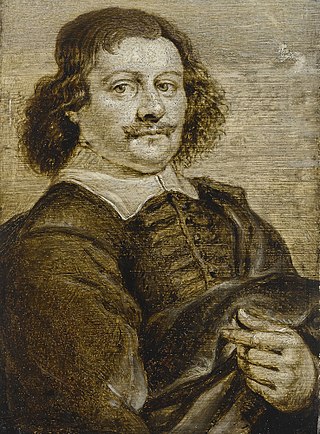
Jan Dirksz Both was a Dutch painter, draughtsman, and etcher, who made an important contribution to the development of Dutch Italianate landscape painting.

Dutch Golden Age painting is the painting of the Dutch Golden Age, a period in Dutch history roughly spanning the 17th century, during and after the later part of the Eighty Years' War (1568–1648) for Dutch independence.

Abraham Brueghel was a Flemish painter from the famous Brueghel family of artists. He emigrated at a young age to Italy where he played an important role in the development of the style of decorative Baroque still lifes.

Adriaen van Utrecht was a Flemish painter known mainly for his sumptuous banquet still lifes, game and fruit still lifes, fruit garlands, market and kitchen scenes and depictions of live poultry in farmyards. His paintings, especially the hunting and game pieces, show the influence of Frans Snyders. The two artists are considered the main inventors of the genre of the pronkstillevens, i.e. still lifes that emphasized abundance by depicting a diversity of objects, fruits, flowers and dead game, often together with living people and animals. Van Utrecht also painted a number of flower still lifes. He was a regular collaborator with leading Antwerp painters who had been pupils or assistants of Peter Paul Rubens, such as Jacob Jordaens, David Teniers the Younger, Erasmus Quellinus II, Gerard Seghers, Theodoor Rombouts, Abraham van Diepenbeeck and Thomas Willeboirts Bosschaert.

Pieter van Bloemen, also known as Standaart, first name also spelled Peter or Peeter, was a Flemish painter, draughtsman and printmaker. He was a gifted landscape and animal artist and was very successful with his compositions depicting Italian landscapes with figures, equestrian battles, animals and genre and market scenes.
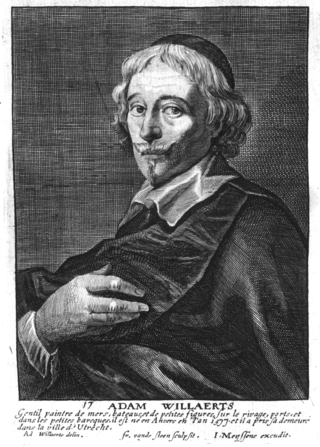
Adam Willaerts was a Dutch Golden Age painter.
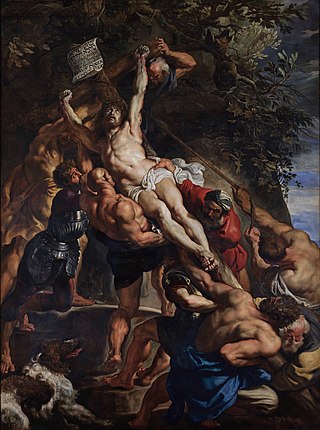
Flemish Baroque painting was a style of painting in the Southern Netherlands during Spanish control in the 16th and 17th centuries. The period roughly begins when the Dutch Republic was split from the Habsburg Spain regions to the south with the Spanish recapturing of Antwerp in 1585 and goes until about 1700, when Spanish Habsburg authority ended with the death of King Charles II. Antwerp, home to the prominent artists Peter Paul Rubens, Anthony van Dyck, and Jacob Jordaens, was the artistic nexus, while other notable cities include Brussels and Ghent.
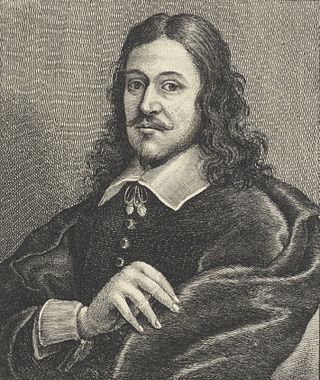
Bonaventura Peeters (I) or Bonaventura Peeters the Elder (23 July 1614 – 25 July 1652) was a Flemish painter, draughtsman and etcher. He became one of the leading marine artists in the Low Countries in the first half of the 17th century with his depictions of marine battles, storms at sea, shipwrecks and views of ships in rivers and harbours.

Matthias Stom or Matthias Stomer was a Dutch, or possibly Flemish, painter who is only known for the works he produced during his residence in Italy. He was influenced by the work of non-Italian followers of Caravaggio in Italy, in particular his Dutch followers often referred to as the Utrecht Caravaggists, as well as by Jusepe de Ribera and Peter Paul Rubens. He did not share the other Northern Caravaggisti's preference for humorous, and sometimes scabrous, genre scenes and elaborate decorative allegories but favored stories from the bible instead. He worked in various locations in Italy where he enjoyed the patronage of religious institutions as well as prominent members of the nobility.
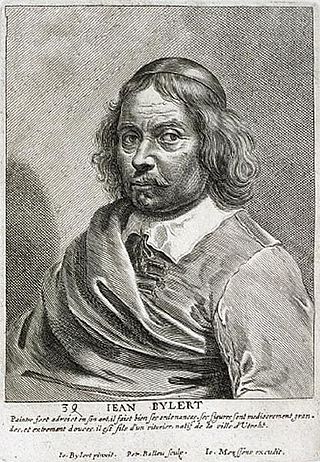
Jan Hermansz van Bijlert was a Dutch Golden Age painter from Utrecht, one of the Utrecht Caravaggisti whose style was influenced by Caravaggio. He spent some four years in Italy and was one of the founders of the Bentvueghels circle of northern painters in Rome.
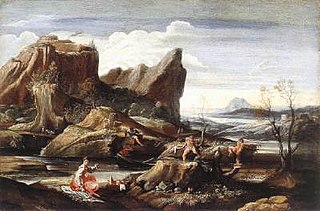
Pieter de Molijn was a Dutch Golden Age painter and engraver of English birth and Flemish descent.
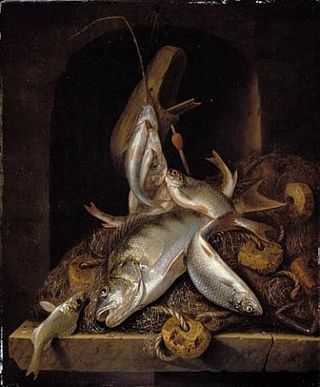
Jacob Gillig was a Dutch Golden Age painter of still lifes, usually of fish. Although he produced several portraits, it is for painting fish that he is best known.

Anton Goubau or Anton Goebouw was a Flemish Baroque painter. He spent time in Rome where he moved in the circle of the Bamboccianti, Dutch and Flemish genre painters who created small cabinet paintings of the everyday life of the lower classes in Rome and its countryside. He is known for his Italianate landscapes and genre paintings in the style of the Bamboccianti and his history paintings with mythological and religious themes.

Gennaro Greco also known as "Il Mascacotta" (1663–1714) was an Italian architectural painter who was active in Naples during the late Baroque period. He is known for his architectural paintings, capricci, compositions with ruins, as well as his vedute. His vedute fall mostly in the category of the so-called vedute ideate which represent closely observed views of completely imaginary landscapes.
Jan Baptist Brueghel was a Flemish Baroque flower painter.

Franciscus de Neve (II) (also: Frans de (II) Neve, Fraciscus de Neuff, Francesco della Neve and nicknames: Bloosaerken and Blaserken) (1632, Antwerp – after 1704) was a Flemish painter and engraver. He is known for his late Baroque religious and mythological scenes and landscapes. He had an international career in Italy, Southern Germany and Austria where he worked for aristocratic patrons and churches; He returned to his native Flanders later in his life.
Willem Ormea (1611–1673) was a Dutch Golden Age painter known for his still lifes of subjects such as fish.

Isaac Willaerts was a Dutch painter who specialized in coastal landscapes and maritime scenes.